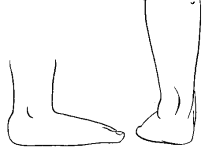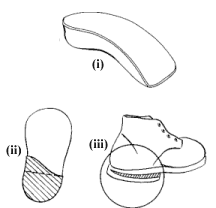
|
|||||||
Flatfeet
Flatfeet is a condition where the longitudinal arch of the foot is absent. It is also called pes planus or pes valgus, since the heel or hindfoot is often in valgus or flared outwards.
 Fig: note
the absence of the arch, and the outflare of the heel cord or Achilles
tendon.
Fig: note
the absence of the arch, and the outflare of the heel cord or Achilles
tendon.
Flatfeet may be flexible or rigid. Flexible or postural flatfeet is when the arch is present with the foot non-weight bearing, and absent when the foot is weight bearing. Rigid flatfeet is when the arch is absent regardless of weight bearing, and is usually associated with a rigid or inflexible foot.
What causes it?
The unique arrangements of the bones of the foot and the ligaments holding them together provide the foot with a longitudinal arch, an architectural system that provides a stable yet flexible support for the body when standing and walking.
In the child before age 3, the normal longitudinal arch of the foot is present, but often masked by the fat pad in the instep. Hence all young children before age 3 look flat-footed, even though they are not. After age 3, the fat pad disappears, and the arch becomes more evident.
In some children, the ligaments of the foot are lax, thus allowing the longitudinal arch to fall on standing, giving rise to flexible flatfeet. This is especially pronounced in children with Down’s syndrome, where the muscles and ligaments of the body are very lax.
In rare instances, rigid flatfeet arises from abnormal foot development, as in congenital convex pes valgus and tarsal coalition.
What are the symptoms?
Flexible flatfeet is asymptomatic, and the child is often brought to the doctor because of concerns about how the feet look when the child is standing or walking. Very often, one of the parents may have flatfeet and wants something done for Johnny so that he will not "suffer the same fate" as Daddy. Flexible flatfeet is not painful. Only the most severe cases may cause foot strain in adult life.
Rigid flatfeet is more serious, and can be painful. Congenital convex pes valgus is present at birth, and is obvious to any observer. The foot is very rigid and need aggressive treatment. Tarsal coalition presents at around age 10 when the child starts to complain of foot pain during activities.
What does your doctor do about it?
For the majority of children with flexible flatfeet, no treatment is necessary, especially under the age of 3.
In older children where the longitudinal arch is pronounced, arch supports may be needed. For children, ready-made plastic, rather than expensive custom arch supports are recommended, since they have a habit of outgrowing them rather quickly. A commonly used arch support is the UCB, so-called because it was developed at the University of California Biomechanics Lab. The arch supports are usually worn from age 3 to age 8. It is important to understand that they do not correct or reverse the flatfeet, only control it. At the end of treatment, the child may still end up with some degree of flatfeet. The purpose of the arch supports is to prevent it from getting worse. As mentioned above, if the arch supports can prevent flatfeet from getting worse, no pain or disability need by expected in adult life.
 Fig:
(i)Thermoplastic arch support for use with tennis shoes, (ii)corrective
shoe with Thomas heel, (iii) corrective shoe with inner (medial) heel
wedge.
Fig:
(i)Thermoplastic arch support for use with tennis shoes, (ii)corrective
shoe with Thomas heel, (iii) corrective shoe with inner (medial) heel
wedge.
Adapted from the book Is Your Child Walking Right? by Andrew Chong, M.D.
NOTICE: The information presented is for your information only, and not a substitute for the medical advice of a qualified physician. Neither the author nor the publisher will be responsible for any harm or injury resulting from interpretations of the materials in this article.
Questions
or comments? Post your thoughts in the Orthoseek
Message Forum!
Find a pediatric orthopedic surgeon
in an area near you.
Home | About Us | Orthopaedic Topics | Message Forum
![]()
Comments, questions, or suggestions are welcome. Please
contact us using this form.